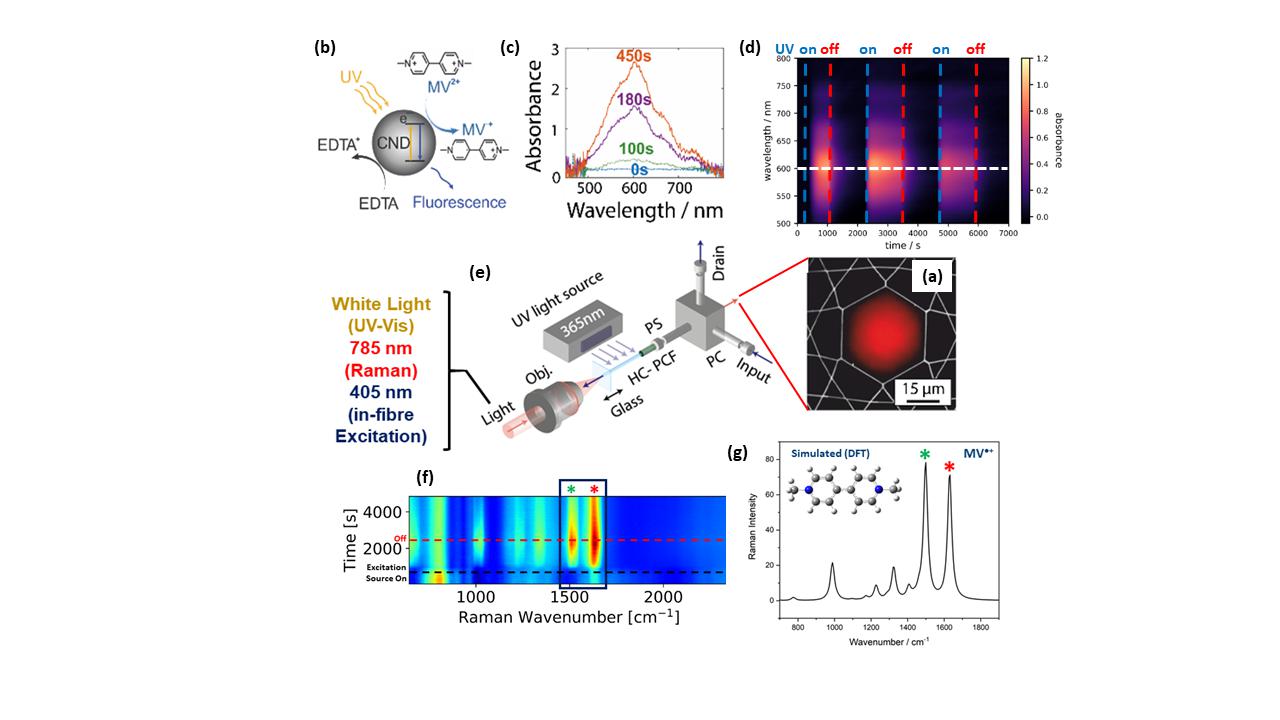In-situ Monitoring of Photocatalytic Processes within Optofluidic Hollow-Core Fibre Microreactors using Various Spectroscopic Techniques
- Date: Thu, 14 Apr 2022, 11:00 am - 12:00 pm
- Location: The Braggs Building, Level 2
- Contact: Thanh Nguyen
- Email: thanh.nguyen@adelaide.edu.au
In-situ Monitoring of Photocatalytic Processes within Optofluidic Hollow-Core Fibre Microreactors using Various Spectroscopic Techniques
Optofluidic hollow-core photonic crystal fibers (HC-PCFs) allow low-loss light guidance at the centre of a microfluidic channel (Figure 1a). This maximises light interaction with infiltrated samples, offering unique opportunities for in-situ monitoring of photocatalytic reactions [1]. Compared to standard cuvettes, HC-PCFs can reduce reaction volumes by five orders of magnitude (ca. 50 nL), while long optical path lengths enable detection of reaction products at extremely-low concentrations (with sub-picomole sensitivity) [2,3]. Liquid-filled HC-PCFs microreactors are used for photocatalysis and concurrently implement spectroscopic techniques for in-situ monitoring of underlying photocatalytic systems (e.g. artificial photosynthesis for hydrogen production).

Figure 1: (a) SEM image of a kagomé-style fiber with a measured optical mode at 600 nm superimposed; (b) schematic of CND-based photoreduction of MV2+ with EDTA used as a sacrificial electron donor; (c) and (d) Absorption spectra of MV•+ across different times and UV on/off cycles; (e) HC-PCF experimental setup; (f) and (g) Experimental and Simulated Raman Spectra of MV•+.
In the optofluidics group at the Cavendish Laboratory, we have developed multiple setups utilising HC-PCFs (e.g., Figure 1e) to investigate the intricate details underlying photocatalytic systems. More specifically, we aim to gain more insight into the electron transfer kinetics of photosensitisers (PSs); a key component comprising photocatalytic systems utilised in solar fuel production [4]. One particular type of PS of interest to our group are carbon nanodots (CNDs), which are proposed as next-generation PSs due to their unique advantages over conventionally-implemented PSs (e.g. Ru(bpy)32+), such as scalability, biocompatibility, water solubility, and stable optical properties [4], together with being effective light-harvesters in photocatalytic systems for solar fuel production [4,5].
We have studied the electron-transfer properties of CNDs by in-fibra UV-Vis and Raman spectroscopy using viologens (XV2+) as indicators (e.g. MV2+ - Figure 1b) [1,6]. Upon absorption of UV/Near-UV light (Figure 1e), CNDs can transfer an electron to XV2+, forming a radical cation (XV•+) which possesses: (a) strong optical absorption at 600 nm (Figure 1c), and (b) Higher-intensity Raman bands than their XV2+ counterparts (Figures 1f and g). For (a), this band's evolution during UV irradiation cycles (Figure 1d) is interpreted with a quantitative kinetic model to determine the CND-driven photoreduction and photobleaching rate constants for XV2+. For (b), the observed changes in Raman spectra as XV•+ as is formed, compared to Density Functional Theory-simulated Raman spectra (Figure 1g), elucidates structural changes of the photocatalytic system components; information that is unattainable via UV-Vis spectroscopy.
For my seminar, I will discuss these results in more detail in addition to presenting some additional work on other photocalaytic systems of interest. Overall, I will show how these investigations demonstrate that HC-PCF microreactors are a powerful tool for in-situ detection and low-volume screening for photocatalytic reactions.
References:
[1] P. Koehler et al., Anal. Chem. 93, 895 (2021).
[2] M. Schmidt et al., ChemCatChem 5, 641 (2013).
[3] G. O. S. Williams et al., Lab on a Chip 12, 3356 (2012).
[4] B. C. M. Martindale et al., Angew. Chem. Int. Ed. 56, 6459 (2017).
[5] G. A. M. Hutton et al., Chem. Soc. Rev. 46, 6111 (2017).
[6] A. S. Gentleman et al., 2020 Conference on Lasers and Electro-Optics Pacific Rim (CLEO-PR), 2020, pp. 1-2, doi: 10.1364/CLEOPR.2020.C2H_2.
